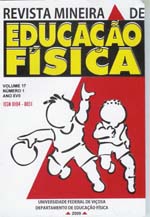COMPARISON BETWEEN THE HEART RATE VARIABILITY AND THE ANTHROPOMETRIC DISPLAY OF CARDIOVASCULAR RISK IN A PHYSICALLY ACTIVE FEMALE POPULATION
Keywords:
waist circumference, heart rate variability, physical exercise, cardiovascular risk and obesityAbstract
The Heart Rate Variability (HRV) is a noninvasive technique to assess the functioning of the autonomic nervous system. An enlarged Waist Circumference (WC) is an indicator of obesity, therefore a predictor of increased risk of cardiovascular disease. OBJECTIVES: To analyze the changes of autonomic response in two groups of young women, obese and non-obese, classified using the WC. MATERIALS AND METHODS: The study included 12 female volunteers divided in a balanced way in obese and non-obese, who underwent an incremental treadmill protocol. The HRV parameters analyzed were SDNN, RMSSD, HF, LF and LF/HF ratio, determined by the R-R interval registry obtained by a Polar S810 heart rate monitor and analyzed by Kubios HRV software, version 2.0. RESULTS: There were no differences observed between groups in the HRV parameters after the first minute of active recovery, checking, however, a tendency to higher average LF values after 20 minutes of passive recovery in the obese women group. DISCUSSION: Opposing some literature that refers to lower HRV in obese women, this study’s results point to a similar behavior after the first minute of active recovery in both groups. However, it is noticed an increase in parasympathetic influence in the group of non-obese, after a 20 minutes passive recovery, this behavior may be constituted with potential in predicting the cardiovascular risk. CONCLUSION: We conclude that the young obese women group has lower heart rate variability after 20 minutes of passive recovery, when compared with a normoponderal group.
Downloads
References
ACTHEN, J.; JEUKENDRUP, A.E. Heart rate monitoring: applications and limitations. Sports Medicine, Stuttgart, v.30, n.7, p.517-38, 2003.
ARAÚJO, C. G. S. et al. Heart rate responses to deep breathing and 4-seconds of exercise before and after pharmacological blockade with atropine and propranolol. Clin. Auton. Res., v. 2, p. 35-40, 1992.
BARRETO, S. et al. Análise da estratégia global para alimentação, atividade física e saúde, da Organização Mundial de Saúde. Epidemiologia & Saúde, v. 14, n. 1, p. 41-58, 2005.
COLE, C. R. et al. Heart rate recovery immediately after exercise as a predictor of mortality. N Engl. J. Med., v. 341, p. 1351-1357, 1999.
GALLO JR. et al. Control of heart rate during exercise in health and disease. Braz. J. Med. Biol. Res., v. 28, n. 11-12, p. 1179-84, 1995.
LEAN, M. E. et al. Waist circumference as a measure for indicating need for weight management. BMJ, v. 311, p. 158-61, 1995.
KRAGELUND, C.; OMLAND, T. A farewell to body-mass index. Lancet, v. 366, n. 9497, p. 1589-91, 2005.
HERMSDORFF, H. H. M.; MONTEIRO, J. B. R. Gordura visceral, subcutânea ou intramuscular: onde está o problema? Arquivos Brasileiros de Endocrinologia & Metabologia, São Paulo, v. 48, n. 6, p.803-811, dez. 2004.
HEYWARD, V. H.; STOLARCZYK, L. M. Avaliação da composição corporal. São Paulo: Manole, 2000.
JASON, N. G. et al. Autonomic effects on the spectral analysis of heart rate variability after exercise. Am. J. Physiol. Heart Circ. Physiol., v. 297, p. H1421–H1428, 2009.
LOHMAN, T. G. Advances in body composition assessment. Champaign, IL: Human Kinetics, 1992.
MOLARIUS, A. et al. Waist and hip circumferences, and waist-hip ratio in 19 populations of the WHO MONICA Project. Int. J. Obes. Relat. Metab. Disord., v. 23, p. 116-25, 1999.
NAKAMURA, F. Y. et al. Alteração do limiar de variabilidade da frequência cardíaca após treinamento aeróbio de curto prazo. Motriz, v. 11, n. 1, p. 1-10, 2005.
NEGRÃO, C. et al. O papel do sedentarismo na obesidade. Revista Brasileira de Hipertensão, v. 2, p. 149-155, 2000.
ROBERGS, R. A.; LANDWERHR, R. The surprising history of the “hrmax=220-age” equation. An International Electronic Journal, v. 5, n. 2, May 2002.
RUMENIG, E. Cinética e variabilidade da frequência cardíaca mediante exercício físico predominantemente aeróbio: influência da intensidade e do tempo de análise. Rev. bras. Educ. Fís. Esp., São Paulo, v. 21, n. 3, p. 205-18, jul./set. 2007.
SCHEERET et al. Impact of the human circadian system, exercise, and their interaction on cardiovascular function. PNAS, v. 107, n. 47, 2010.
TAYLOR, R. W. et al. Evaluation of waist circumference, waist-to-hip ratio, and conicity index as screening tools for high trunk fat mass, as measures by dual-energy by dual-energy X-ray absorptiometry, in children aged 3-19 y. Am. J. Clin. Nutr., v. 72, p. 490-5, 2000.
TASK FORCE OF THE EUROPEAN SOCIETY OF CARDIOLOGY THE NORTH AMERICAN SOCIETY OF PACING ELECTROPHISIOLOGY. Standards of Measurement, Physiological Interpretation, and Clinical Use, Londres, v. 93, n. 5, p. 1043-1065, 1996.
WAJCHENBERG, B. L. Subcutaneous and visceral adipose tissue: their relation to the metabolic syndrome. Endocr. Rev., v. 21, p. 697-738, 2000.
Downloads
Published
How to Cite
Issue
Section
License
Os artigos submetidos e publicados são de inteira responsabilidade de seus autores, não refletindo necessariamente a opinião do Comitê Editorial. A revista se reserva o direito de efetuar, nos originais, alterações de ordem normativa, ortográfica e gramatical, com vistas a manter o padrão culto da língua, respeitando, porém, o estilo dos autores. O manuscrito submetido deve ser original, não podendo ter sido publicado em qualquer outro veículo de informação científica, e nem submetido para publicação em outra revista científica. Os trabalhos publicados passam a ser propriedade da revista Mineira de Educação Física, ficando sua reimpressão total ou parcial de acordo com a licença Creative Commons Attibution 4.0. Deve ser consignada a fonte de publicação original. Os originais não serão devolvidos aos autores. As opiniões emitidas pelos autores dos artigos são de sua exclusiva responsabilidade.





 Esta obra está licenciada com uma Licença
Esta obra está licenciada com uma Licença 